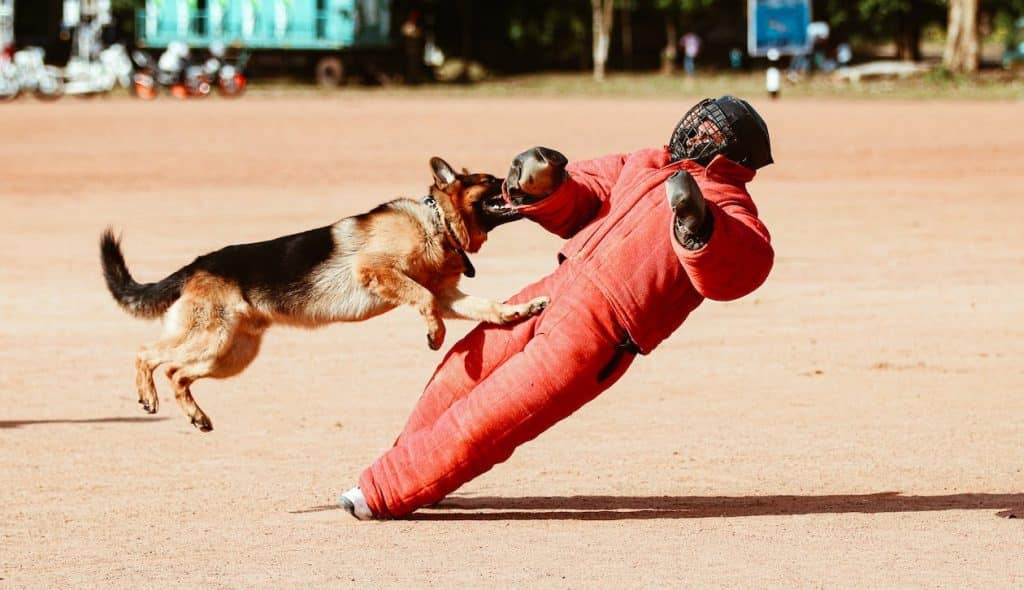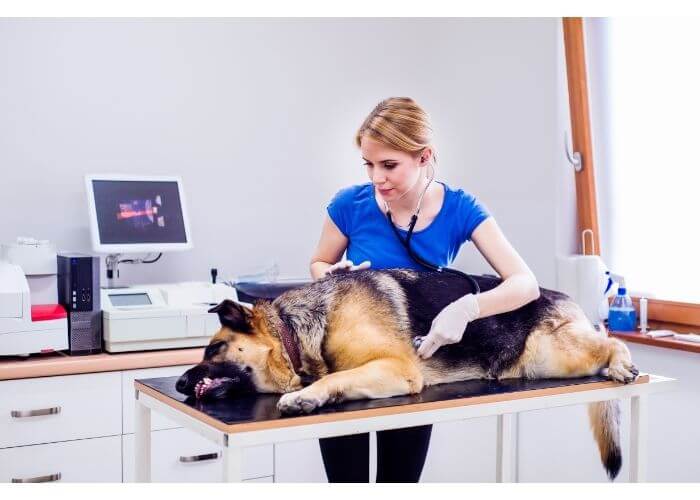German shepherds are friendly and active breeds. They love playing with their owners, walking with them, and swimming. That’s why I bought my German shepherd dog, at least, to have a playing mate. Last year, December 15th, was the most challenging time of my life.
I was having a morning walk with my buddy when all of a sudden, he started limping. I thought he had stepped on something, but my eyes could not see anything. A couple of hours later, he lay down and didn’t want to get up. Worst still, he seemed to be in severe pain.
I was scared because I had heard about hip dysplasia, but how common is hip dysplasia in German Shepherds? A quick call to my vet confirmed my fears!
German shepherds are prone to hip dysplasia (HP), a common hereditary condition in large breeds. Initially, canine hip dysplasia occurrence was 21.2 percent. In dogs, hip dysplasia was 15.7 percent. German shepherds develop HP as early as 24 weeks. Mostly, it’s noticed at 9 to 12 months. A German shepherd with hip dysplasia can live many years.
So…
How Common Is Hip Dysplasia In German Shepherds?
At least 19.8 percent of German shepherd dogs (GSDs) suffer from hip Dysplasia. Orthopedic Foundation further says that these findings are based on GSDs born between 2011 and 2015.
The age of your German shepherd dog and the level of the misalignment of his hip are some of the factors that determine the type of treatment to be offered.
Hip dysplasia is painful in German shepherd dogs. It can affect GSD of any age and size. Hip dysplasia affects all canines, not just German shepherd dogs. You’ll, therefore, hear terms such as Canine Hip Dysplasia among pet owners.
What Is Canine Hip Dysplasia (CHD)?
This is a skeletal condition among canines. Though it also affects smaller breeds, large dogs such as German shepherds are highly prone to hip dysplasia.
A normal dog’s hip joint has a socket and a ball that slides smoothly whenever he walks. With CHD, however, the ball and the socket do not fit well, hence causing pain to the canine.
Sometimes they fail to develop well, too. Consequently, the joints fail to function appropriately if not treated.
Are German Shepherds Prone To Hip Dysplasia?
Since the German shepherd is among large breeds, it’s prone to hip dysplasia. Out of Five German shepherd dogs, it’s possible to have one with hip dysplasia.
In other words, at least 20 percent of German shepherd dogs get hip dysplasia.
How Long Can A German Shepherd Live With Hip Dysplasia?
Unless your German shepherd dog is in extreme pain and no treatment is offered, he can live many years.
However, if he is aged, like, say, 7 years plus, it would be necessary to have a support system that would make walking easier for him.
Major Causes of Hip Dysplasia in German Shepherd Dogs
Like in other large breeds (and a few smaller breeds), hip dysplasia in German shepherd dogs can be caused by a variety of factors. Knowing each of these factors could play a big role in preventing hip dysplasia in your German shepherd dog.
Genetics
Hip dysplasia can be inherited from one GSD to another. Most large dogs, such as German Shepherds and Saint Bernards, are prone to this genetic predisposition.
Exercise
Exercises that drain the energy (ATP) stored in your German shepherd fast heighten the risks of hip dysplasia.
Such include anaerobic exercises. Limit such exercises in your German shepherds. Let there be a balance; allow your dog to have enough exercise depending on his age and size. Lack of it or too much of it would cause hip dysplasia.

Diet
Large breeds need a diet that slows down their growth. Such diets must be balanced. This gives all joints time to mature well without unnecessary weight straining them. Otherwise, your German shepherd may develop skeletal disorders due to extreme growth.
At all costs, avoid a diet that can make your German shepherd dog obese.
Neutering Early
Out of the male GSDs that were neutered at an early age, 10 percent suffered from hip dysplasia. While many non-neutered GSDs have hip dysplasia, neutering at an early age doubles the risk. German shepherd pups neutered at six months old or less are 1.5 times more likely to get hip dysplasia. As a result, they become lame.
Symptoms of Hip Dysplasia in Dogs
German shepherd dogs can get hip dysplasia as early as 3 weeks. However, symptoms only manifest at 4 to 6 months. This is why it’s possible for the disease to worsen over time. Note, however, that the symptoms differ depending on the severity or stage of the disease.
A keen eye would help to tell that your German shepherd is suffering from Hip Dysplasia. You'll easily notice the following in your GSD:
- Use of one leg when walking
- Being reluctant to play
- Limping
- Hind legs are lame
- Trouble walking, climbing stairs, running, getting up, and jumping
- Pain
- Swaying gait (Bunny hopping)
- Low thigh muscle weight
- Shoulder muscle enlargement
Late-stage of Hip Dysplasia
- Constipation
- Anxiety
- Depression
- Inability to get up
- Fecal and urinary incontinence
- Muscle atrophy
- Organ failure
Treatment: Can German Shepherd Hip Dysplasia Be Cured?
Yes, most German shepherd hip dysplasia is curable. Depending on its severity, your vet might recommend surgical or non-surgical treatment.
Non-surgical may call for a change in diet and general lifestyle. Severe cases, on the other hand, may call for surgical treatment.
Non-Surgical Treatment
- Joint supplements and modifiers
- Lowering his body mass to reduce the stress on his hips
- Physical therapy
- Administration of medication (Anti-inflammatory)
- Limitation of exercises
Surgical Treatment
- Total Hip Replacement (THR)
- Double Pelvic Osteotomy/Triple Pelvic Osteotomy (DPO/TPO)
- Femoral Head Ostectomy (FHO)
Total Hip Replacement (THR)
THR is most recommended where the German shepherd dog’s hope of ever walking or getting up is zero or close to zero.
If done by experts in a professional way, it can be a sure way of treating hip dysplasia in your GSD. The joints are replaced with plastic and metal implants. After healing, the discomfort ceases, and your German shepherd dog’s hip functions normally again.
Triple Pelvic Osteotomy/ Double Pelvic Osteotomy (TPO/DPO)
Surgeons perform TPO/DPO on German shepherds, usually pups aged 10 months and below.
Surgeons cut the pelvic bone and rotate its segments. Consequently, the functionality of the ball and the socket joint improves.
Femoral Head Ostectomy (FHO)
To effectively manage extreme pain in puppies and adult German shepherd dogs, FHO is conducted. The hip joint’s femoral head is cut to create a ‘fake’ joint. The pain that was associated with hip dysplasia, as well as the discomfort, henceforth ceases.
How Much Is Hip Dysplasia Surgery For German Shepherd Dogs?
The cost of hip dysplasia depends on the condition of the problem. Severe cases may cost you more, while early conditions cost less.
The current health, size, and age of your German shepherd also play a part in determining the cost. If your dog has underlying health issues, it could be risky to do an operation on him. As such, veterinaries might charge you more.
Generally, though, German shepherds whose condition has deteriorated and left them lame or in total pain may need Total Hip Dysplasia (THP). Such could cost you approximately 3,500 to 7,000 dollars per hip.
In most cases, both hips are usually affected. That doubles up the cost since both hips will be replaced. These costs cover surgery, pre-surgical blood work, medications, and anesthesia.
How to Prevent German Shepherd Hip Dysplasia
Preventing hip dysplasia in German shepherd dogs can be a hard nut to crack because not all cases are avoidable.
That, however, doesn’t mean there’s nothing you can do to lower the chances of hip dysplasia. A good diet, screening the breed, and exercise are some of the effective ways of preventing hip dysplasia.
Screen the Breed
Screening before buying a German shepherd dog is vital as it helps to identify and avoid hereditary hip dysplasia. Avoid a GSD whose screening results are rated low.
Only buy or adopt a German shepherd dog whose hip joints grade rating is normal or high. Orthopedic Foundation for Animals can do the screening for you and give you the right advice depending on the results.
Also, if you are a breeder, do frequent health screenings on all your dogs. Such may include hip dysplasia radiographs.
Exercise
It can be scary, especially when you realize that your German shepherd is bearing the pain of Hip Dysplasia. The last thing you want is to cause him more strain or pain. Probably all you want is to have him sleep and eat well.
The truth is, you would be causing more harm than good. You should walk your German Shepherd dog with hip dysplasia.
Walking your dog is a low-impact exercise that is suitable for the muscles around his joints. Moderate running, too, is vital for the strengthening of his joint muscles.
Also, you should exercise your German shepherd dog with hip dysplasia because the low-impact exercise helps in the strengthening of the joint muscles.

On the other hand, high-impact exercise strengthens the large muscles. Consequently, the ball and socket hip joint get enough support which helps your German shepherd to heal dysplasia quickly. Nonetheless, consult your doctor about the same.
Diet
Obese German shepherd dogs are more prone to hip dysplasia. The weight on his hips becomes too much, hence causing hip dysplasia.
Invest in high-quality commercial German shepherd foods. Alongside meat, add vegetables, grains, and fruits. From such a diet, your GSD will benefit from nutrients such as fiber, vitamins, and minerals.
Wrapping Up
German shepherds are highly exposed to hip dysplasia. That, however, doesn’t mean all of them suffer from this condition. By giving your buddy the right care in terms of diet, exercise, and breeding, you can save him from this monster.
Even so, if you happen to be unlucky and your GSD develops hip dysplasia, there’s no point in fretting. With excellent care as instructed by your vet, your GSD can enjoy life with you and live long as expected.


